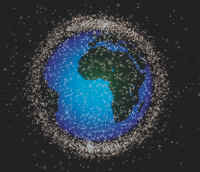
Our experience
Fraunhofer EMI disposes of long-term experience in analyzing hypervelocity impacts on components of spacecraft. In the 1980s, for example, we designed and tested a protective shield for the Giotto space probe which protected various components at the surface of the probe against the bombardment of dust particles of the comet Halley.
In further studies, solar cells were impacted by millimeter-sized pellets. They were necessary to calibrate the damages caused by space debris and micrometeorites on the Long Duration Exposure Facility LDEF and on the Hubble Space Telescope HST. A major study dealt with testing and experimentally optimizing the protection shield of the Columbus research laboratory of the European Space Agency ESA. The Columbus laboratory is supposed to become part of the International Space Station ISS. By using novel materials, the protective effects of the shield could be considerably increased compared to the originally intended version.
A current investigation at EMI analyzes the effects of space-debris impacts on optical mirrors as they will be utilized for the future generation of telecommunication satellites. The risk analysis encompasses a thorough analysis of particle fluxes, the conduction of simulation experiments and subsequent calculation of the expected overall damage.
Our method
A comprehensive investigation includes the analysis of the hazard potential posed by space debris and micrometeorites in the observed orbit, the identification of critical components at the surface of the spacecraft, the investigation of the damage of these components by space-debris impacts, the design of protective structures, the testing of protective measures by impact tests as well as numerical simulations.
Analysis of the hazard potential:
Insights and knowledge about particle fluxes in the near-earth orbit are constantly changing, especially in the millimeter and centimeter range. That is why Ernst-Mach-Institut resorts to current data from specialist literature. For the calculation of particle fluxes in any near-earth orbit, modeling software by ESA and NASA is used (the ESA MASTER model and the NASA ORDEM 96 model). For detailed investigations, the analysis software ESABASE/DEBRIS is employed to model the structure of spacecraft and to calculate impact probabilities on single components.
Experimental analysis of protective shields by means of impact tests:
A core competence of EMI forms the experimental simulation of impact processes with the help of impact facilities unique in Europe. They allow for the acceleration of the relevant particle masses reaching from micrograms to grams to velocities of up to ten kilometers per second. With the help of this technology, almost any kind of particle forms can be accelerated. Extensive diagnostics, i.e., pressure sensor systems and high-speed photography, provides insights into each phase of the impact process and can effectively be used for the optimization of the protective structures.
Identification of critical components:
Knowledge concerning type and position of the component observed provides information about existing and avoidable risks. Ernst-Mach-Institut is equipped with wide-ranging experience in assessing expected damages and uses this experience to identify critical components.
Investigation of component damage:
Some components cannot be protected as, for example, solar panels. In such cases, the maximum damage of such components can be determined in analytical and experimental approaches.
Design of protective structures:
For the design of protective structures, we draw on extensive, application-related knowledge which is supported by information on the behavior of all kinds of materials and structural components under impact loading. In many cases, effective protection can already be achieved by lightweight and cost-efficient protective shields.
Numerical simulation:
The experimental results are complemented by computer simulations. On the one hand, this helps to simulate deliberate parameter variations cost- and time-efficiently. On the other hand, impact behavior can be analyzed for collision velocities which are no longer accessible in experiment. This way, you can examine whether the protective effect of a shield is still valid at maximum collision velocities. Furthermore, all physically relevant parameters, like pressure, density and temperature, can be recorded for each phase of the impact. The targeted combination of analytical damage limits and computer simulations helps to determine the most appropriate protective structure for a given situation even prior to the experimental investigation.